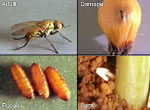Nematodes
Nematodes?! Sound familiar? Haven’t we read about them somewhere? That’s right, parasitic nematodes. But aren’t they good ‘todes? Yes, the parasitic ones we’ve referenced are, but not all nematodes were created equal. Some are good as we can utilize them to our advantage. Others can physically injure humans. And some are root pests. There are, perhaps, more nematodes on earth than any other multicellular organism. Overall, few are evil. Nematodes vary immensely in size from one species to the next. These pestiferous nematodes tend to be on the small end of the scale, ranging from much less than one millimeter to several millimeters. They live in the soil feeding on root structures and the detritus resulting from their behavior. Their feeding causes all sorts of plant disfigurement and nasty growths — on both the roots and above-ground plant parts. Pestiferous nematodes are extremely difficult to get rid of. There are powerful chemicals designed to kill nematodes (and these will kill the good ones, too), but they really should be used only if all other means of control do not work. There are only three things which have proven themselves capable. The first is to border-plant the field or garden with a nematicidal marigold bush which repels nematodes, Tagetes minutum. These commercially available (by seed) marigolds, if planted densely enough, can keep an uninfested plot clean. The second would be to heavily enrich the soil with clean, composted organic matter. This is to make soil conditions less favorable for the bad nematodes. The third treatment of which we know, one that is safer than most — environmentally speaking. This is a granular product made of, basically, crab shells. It is the natural chitins in the shell material which makes rough the lives of these pests. Other plans to implement if you’re dealing with nematodes would include a defense of crop-rotation and an offense of soil sterilization (if possible). Unfortunately, and this will seem like a first, parasitic nematodes do not impact the lives of their evil brethren. But good nematodes don’t parasitize earthworms, either, so there’s bad news and good.
Onion Maggots

Onion Maggots are the larvae of nondescript seven millimeter stereotypical fly-looking flies. The adult flies lay their eggs at the base of certain allium- or onion-family plants. The eggs hatch and the off-white larvae tunnel into onions-often causing extensive damage and set rots. Their feeding can literally wipe out a crop, especially one located in a cool and moist environment. Row covers can keep out the flies, but some may develop within the confines of the cover. (This is one of the reasons why crop rotation is such a wise choice in gardens and agricultural crops.) Garlic and capsicum wax products may also help keep the flies away, especially if they are applied on or near the soil’s surface. Then again, garlic may be an attractive odor to these particular flies. Parasitic Nematodes can effectively control these pests if they are applied at the right time to target larval forms before they delve too deeply into the onion, and pupal forms in the fall and spring.
Saw Flies

As their name implies, these pests are tiny five millimeter flies. They don’t saw down trees, though. The damage they cause come from their larvae which can decimate leaves of many trees. Current non-chemical control methods include feeding-disruption techniques such as blasting larvae from the leaves they are destroying with streams of water. This, however, is extremely impractical. Other controls may include the use of Parasitic Nematodes as the larvae of these flies pupate in the soil. Other Green products, such as azadirachtin-containing neem-based products, may offer some relief, but check the label for the appropriate listing before making a purchase of said goods.
Slugs and Snails
Everyone is familiar slugs and snails. Slugs are slime-covered creatures which pave a path of slime as they go and typically spend daylight hours nestled under a leaf liter, wood debris, or rocks and pavers. Snails are very similar to slugs, except they carry a shell in which they can hide. Snails, too, spend their days tucked away, but can do so in a wider variety of places since they carry their primary residence with them at all times. Both creatures vary considerably in size, ranging from a few millimeters to several centimeters in length. They also have an affection for plants. Both of these pests come out at night and chew large sections from plants’ leaves and can be very damaging. Some people claim egg shells or diatomaceous earth (DE) sprinkled around plants can deter these slimy creatures. However, slugs (especially slugs) and snails, prefer moist conditions and DE, being a powerful absorptive agent, loses its punch in such conditions. Beer traps have also been known to work so say some. These are basically dishes like pie tins and such with beer in them. These guys go for it, trying to grab a brewski, they fall in and drown. Hic! As another option, copper tape or copper banding is extremely effective in some situations (as may be copper mesh). The element, combined with the creatures’ slime, creates a electrolytic charge which is powerful enough to deter them if it is applied correctly, is appropriate to the circumstances, and is kept as clean as possible. Metaldehyde-containing baits have been successfully used for years. They’re bad news, though, environmentally speaking. Fortunately, there are some new products available which are highly regarded for their safety and earth-friendliness, their ease-of-use, cost, longevity and effectiveness. These newer baits contain iron phosphate. This substance works like the other baits in that it is eaten by the pests and they go away and die. It is different, though, in that remaining pellets break down into non-damaging, nutrient-containing by-products.
